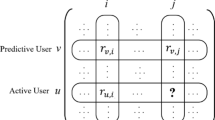Abstract
In this paper, we tackle the incompleteness of user rating history in the context of collaborative filtering for Top-N recommendations. Previous research ignore a fact that two rating patterns exist in the user × item rating matrix and influence each other. More importantly, their interactive influence characterizes the development of each other, which can consequently be exploited to improve the modelling of rating patterns, especially when the user × item rating matrix is highly incomplete due to the well-known data sparsity issue. This paper proposes a Rating Pattern Subspace to iteratively re-optimize the missing values in each user’s rating history by modelling both the global and the personal rating patterns simultaneously. The basic idea is to project the user × item rating matrix on a low-rank subspace to capture the global rating patterns. Then, the projection of each individual user on the subspace is further optimized according to his/her own rating history and the captured global rating patterns. Finally, the optimized user projections are used to improve the modelling of the global rating patterns. Based on this subspace, we propose a RapSVD-L algorithm for Top-N recommendations. In the experiments, the performance of the proposed method is compared with the state-of-the-art Top-N recommendation methods on two real datasets under various data sparsity levels. The experimental results show that RapSVD-L outperforms the compared algorithms not only on the all items recommendations but also on the long tail item recommendations in terms of accuracy.





Similar content being viewed by others
References
Agarwal V, Bharadwaj KK (2012) A collaborative filtering framework for friends recommendation in social networks based on interaction intensity and adaptive user similarity. Soc Netw Anal Min. doi:10.1007/s13278-012-0083-7
Akcora CG, Carminati B, Ferrari E (2013) User similarities on social networks. Soc Netw Anal Min. doi:10.1007/s13278-012-0090-8
Anderson C (2006) The Long Tail: Why the Future of Business Is Selling Less of More, vol 33. Hyperion, New York
Azar Y, Fiat A, Karlin AR, McSherry F, Saia J (2001) Spectral Analysis of Data. In: Proceedings of the thirty-third annual ACM symposium on Theory of computing, pp 619–626
Bento J, Fawaz N, Montanari A, Ioannidis S (2011) Identifying Users From Their Rating Patterns. In: Proceedings of the 2nd Challenge on Context-Aware Movie Recommendation, pp 39–46
Blei DM, Ng AY, Jordan MI (2003) Latent Dirichlet allocation. J Mach Learn Res 3:993–1022
Cremonesi P, Koren Y, Turrin R (2010) Performance of Recommender Algorithms on Top-N Recommendation Tasks. In: Recsys, ACM, New York, pp 39–46
Cremonesi P, Garzotto F, Negro S, Papadopoulos A (2011) Comparative evaluation of recommender system quality. In: Proceedings of CHI Extended Abstracts, pp 1927–1932
Deshpande M, Karypis G (2004) Item-based Top-N recommendation algorithms. ACM TOIS 22(1):143–177
Esslimani I, Brun A, Boyer A (2010) Densifying a behavioral recommender system by social networks link prediction methods. Soc Netw Anal Min 1(3):159–172
Funk S (2006) Netflix update: try this at home. http://sifter.org/~simon/journal/20061211.html
Geng X, Zhou ZH, Smith-Miles K (2007) Automatic age estimation based on facial aging patterns. IEEE TPAMI 29(12):2234–2240
Golub GH, Loan CFV (1996) Introduction to Matrix, vol 1, 3rd edn. The Johns hopkins University Press, Baltimore
Granka LA, Joachims T, Gay G (2004) Eye-Tracking Analysis of User Behavior in WWW Search. In: SIGIR 2004, pp 478–479
Herlocker JL, Konstan JA, Terveen LG, Riedl JT (2004) Evaluating collaborative filtering recommender systems. ACM Trans Inform Syst 22(1):5–53
Hofmann T (2004) Latent Semantic Models for Collaborative Filtering. ACM Trans Inform Syst 22(1):89–115
Karypis G (2001) Evaluation of Item-Based Top-N Recommendation Algorithms. In: CIKM 2001, ACM, New York, pp 247–254
Kim D, Yum Bj (2005) Collaborative Filtering based on Iterative Principal Component Analysis. Expert Syst Appl 28:823–830
Koren Y (2008) Factorization meets the neighborhood: a multifaceted collaborative filtering model. In: SIGKDD 2008. ACM, New York, pp 426–434
Koren Y (2009) Collaborative Filtering with Temporal Dynamics. In: SIGKDD 2009. ACM, New York, pp 447–456
Leonardis A (2000) Robust recognition using eigenimages. Comput Vis Image Underst 78(1):99–118
Li C, Datta A, Sun A (2011) Mining latent relations in peer-production environments: a case study with Wikipedia article similarity and controversy. Soc Netw Anal Min 2(3):265–278
Ma H, King I, Lyu MR (2007) Effective missing data prediction for collaborative filtering. In: SIGIR 2007, ACM Press, New York, pp 39–46
Ning X, Karypis G (2011) SLIM : Sparse linear methods for Top-N recommender systems. In: ICDM 2011, pp 497–506
Niu W, Lei J, Tong E, Li G, Chang L, Shi Z, Ci S (2013) Context-aware service ranking in wireless sensor networks. J Netw Syst Manag. doi:10.1007/s10922-012-9259-8
Paterek A (2007) Improving regularized singular value decomposition for collaborative filtering. In: Proceedings of KDD Cup and Workshop 2007, pp 5–8
Radlinski F, Joachims T (2005) Query chains : learning to rank from implicit feedback. In: SIGKDD 2005, pp 239–248
Ren Y, Li G, Zhang J, Zhou W (2012) Lazy Collaborative filtering for data sets with missing values. IEEE Trans Syst Man Cybern Part B: Cybern
Rettinger A, Wermser H, Huang Y, Tresp V (2012) Context-aware tensor decomposition for relation prediction in social networks. Soc Netw Anal Min 2(4):373–385
Sarwar B, Karypis G, Konstan J, Reidl J (2001) Item-based collaborative filtering recommendation algorithms. In: Proceedings of the 10th international conference on World Wide Web. ACM, New York, pp 285–295
Sarwar BM, Karypis G, Konstan JA, Riedl JT (2000) Application of dimensionality reduction in recommender system—a case study. In: ACM WebKDD Workshop
Vu H, Li G, Sukhorukova N, Beliakov G (2012) K-complex detection using a hybrid-synergic machine learning method. IEEE Trans Syst Man Cybern PartC: Appl Rev 42(6):1478–1490
Author information
Authors and Affiliations
Corresponding author
Rights and permissions
About this article
Cite this article
Ren, Y., Li, G. & Zhou, W. A learning method for Top-N recommendations with incomplete data. Soc. Netw. Anal. Min. 3, 1135–1148 (2013). https://doi.org/10.1007/s13278-013-0103-2
Received:
Revised:
Accepted:
Published:
Issue Date:
DOI: https://doi.org/10.1007/s13278-013-0103-2




